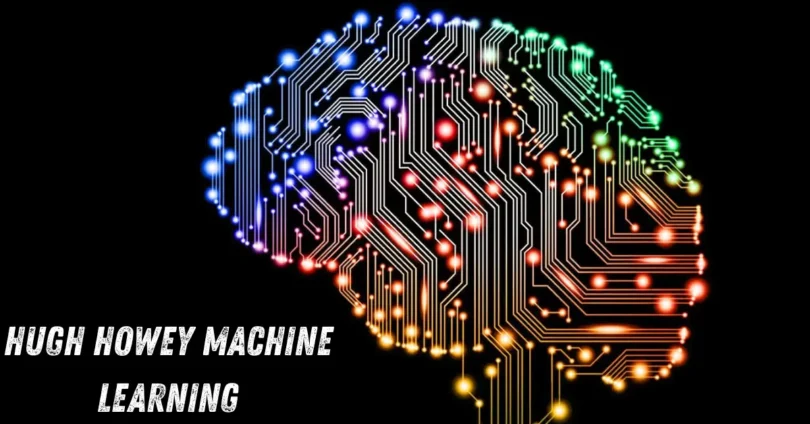Hugh Howey Machine Learning is an exciting topic that connects the world of storytelling with the power of artificial intelligence. Hugh Howey, famous for his futuristic novels like the Silo series, explores ideas about technology and society, and when combined with machine learning, his concepts can inspire new ways to analyze stories, predict reader preferences, and even create data driven storytelling.
Who is Hugh Howey?
Hugh Howey is an American author who became famous for self-publishing his science fiction novels. His Silo series, which explores a dystopian future in underground cities, has been praised worldwide. Hugh Howey’s stories are known for:
- Strong world building and imaginative technology
- Complex characters that feel real
- Plotlines that explore the impact of science and AI on society
By studying Hugh Howey’s work, we can see how fiction often predicts technological trends. Machine learning can help us analyze these predictions and apply them to storytelling or even business applications.
What is Machine Learning?
Machine learning is a type of artificial intelligence that allows computers to learn from data without being explicitly programmed. It is like teaching a computer by giving it many examples and letting it find patterns.
Types of Machine Learning:
- Supervised Learning
- The computer is given labeled data.
- Example: Predicting book ratings based on previous reviews.
- The computer is given labeled data.
- Unsupervised Learning
- The computer finds patterns in unlabeled data.
- Example: Grouping readers by similar interests.
- The computer finds patterns in unlabeled data.
- Reinforcement Learning
- The computer learns by trial and error.
- Example: AI adapting a story based on reader choices.
- The computer learns by trial and error.
Machine learning is everywhere, from Netflix recommendations to voice assistants. By combining it with Hugh Howey’s concepts, we can explore creative and innovative uses.
How Hugh Howey is Ideas Connect to Machine Learning
Hugh Howey often imagines societies shaped by technology. His novels explore themes like artificial intelligence, data privacy, and automation. Machine learning can bring these ideas into reality by:
- Predicting reader preferences based on data
- Analyzing story trends to suggest plot improvements
- Creating interactive storytelling experiences where readers influence outcomes
For example, an AI system can analyze thousands of book reviews and predict what type of ending readers prefer. This aligns with Hugh Howey’s vision of technology shaping human behavior.
Applying Machine Learning Inspired by Hugh Howey
Here is a detailed, easy to follow guide for writers or enthusiasts who want to use machine learning:
1: Collect Data
- Gather data from book reviews, ratings, and social media.
- Example: Collect ratings of 500 sci-fi books from Goodreads.
- Ensure the data is diverse and representative.
2: Clean the Data
- Remove duplicate or incorrect entries.
- Standardize text (lowercase, remove symbols).
- Example: Remove spam reviews or incomplete ratings.
3: Choose a Machine Learning Model
- Start with simple models: Decision Trees, Linear Regression.
- Advanced models: Neural Networks for deep analysis.
- Example: Use a recommendation model to suggest plot twists.
4: Train the Model
- Feed the cleaned data into the model.
- Teach the AI to recognize patterns in reader preferences.
- Example: The model learns that readers enjoy stories with mystery elements.
5: Test the Model
- Check how accurately the AI predicts outcomes.
- Adjust the model based on errors.
- Example: If predictions are wrong, increase dataset size.
6: Apply Insights
- Use AI results to improve story ideas or marketing strategies.
- Example: Decide which book cover will attract more readers.
7: Monitor and Update
- Continuously provide new data to keep the AI accurate.
- Example: Add reviews from new releases to refine predictions.
Tools and Platforms for Beginners
Several tools make it easy to start with machine learning, even without programming experience:
- Google Colab: Free platform to run ML models online.
- Teachable Machine: Simple way to create AI models using images, sound, or text.
- Kaggle Datasets: Free datasets for practice.
- Excel & Python: For analyzing and visualizing data.
Example Dataset
| Book Name | Rating | Genre | Review Count |
| Silo | 4.7 | Sci-Fi | 1200 |
| Wool | 4.5 | Sci-Fi | 950 |
| Shift | 4.3 | Sci-Fi | 800 |
Challenges Authors May Face
Using Hugh Howey Machine Learning is exciting, but it comes with challenges:
- Understanding AI Terminology: Machine learning has technical terms that can be confusing.
- Data Privacy: Collecting reader data must respect privacy rules.
- Over-Reliance on AI: AI should support creativity, not replace it.
- Resource Requirements: Advanced models may need powerful computers.
AI suggests a story ending based purely on reader ratings. It may ignore the author’s unique vision, leading to generic stories.
Future of Storytelling with AI
The combination of Hugh Howey is imagination and machine learning opens new possibilities:
- Personalized Stories: AI can adjust stories based on individual reader preferences.
- Interactive Fiction: Readers can choose plot directions, and AI adapts in real-time.
- Trend Prediction: AI predicts which themes will be popular next.
- Enhanced Creativity: AI generates ideas while the author maintains control.
A reader prefers suspenseful endings. The AI rewrites the last chapter with more suspense while keeping the author’s style intact.
Common FAQs About Hugh Howey Machine Learning
Some faqs of Hugh Howey Machine Learning:
Can beginners use machine learning for writing?
Yes, simple tools allow beginners to analyze data without coding experience.
How much data is needed for ML predictions?
More data usually gives better predictions, but even small datasets can be useful for practice.
Will AI replace authors?
No, AI supports creativity, but human imagination remains essential.
How long does it take to learn basic ML?
A few weeks to a few months, depending on effort and tools used.
Can machine learning analyze reader emotions?
Yes, sentiment analysis can help understand positive or negative feedback.
Is coding required for ML?
Not always beginner friendly platforms allow coding free experiments.
Can ML suggest new story ideas?
Yes, by analyzing patterns and trends from existing books and reader preferences.
Is data privacy important?
Absolutely, any reader information must be collected ethically.
Which books are best to start ML experiments with?
Books with many reviews and ratings, like popular science fiction or fantasy novels.
Can AI predict bestseller potential?
Yes, AI can estimate reader interest, but it is not 100% accurate.
Conclusion
Hugh Howey Machine Learning is a fascinating intersection of creativity and technology. By combining Hugh Howey is imaginative stories with machine learning, writers can gain insights into reader preferences, create interactive experiences, and predict story trends. Beginners can start with small datasets and easy tools, experiment with models, and gradually explore advanced AI applications.
The future of storytelling is exciting, and AI is not here to replace authors but to enhance their creativity. By learning Hugh Howey Machine Learning, writers and enthusiasts can stay ahead in the world of modern storytelling while keeping imagination alive.


